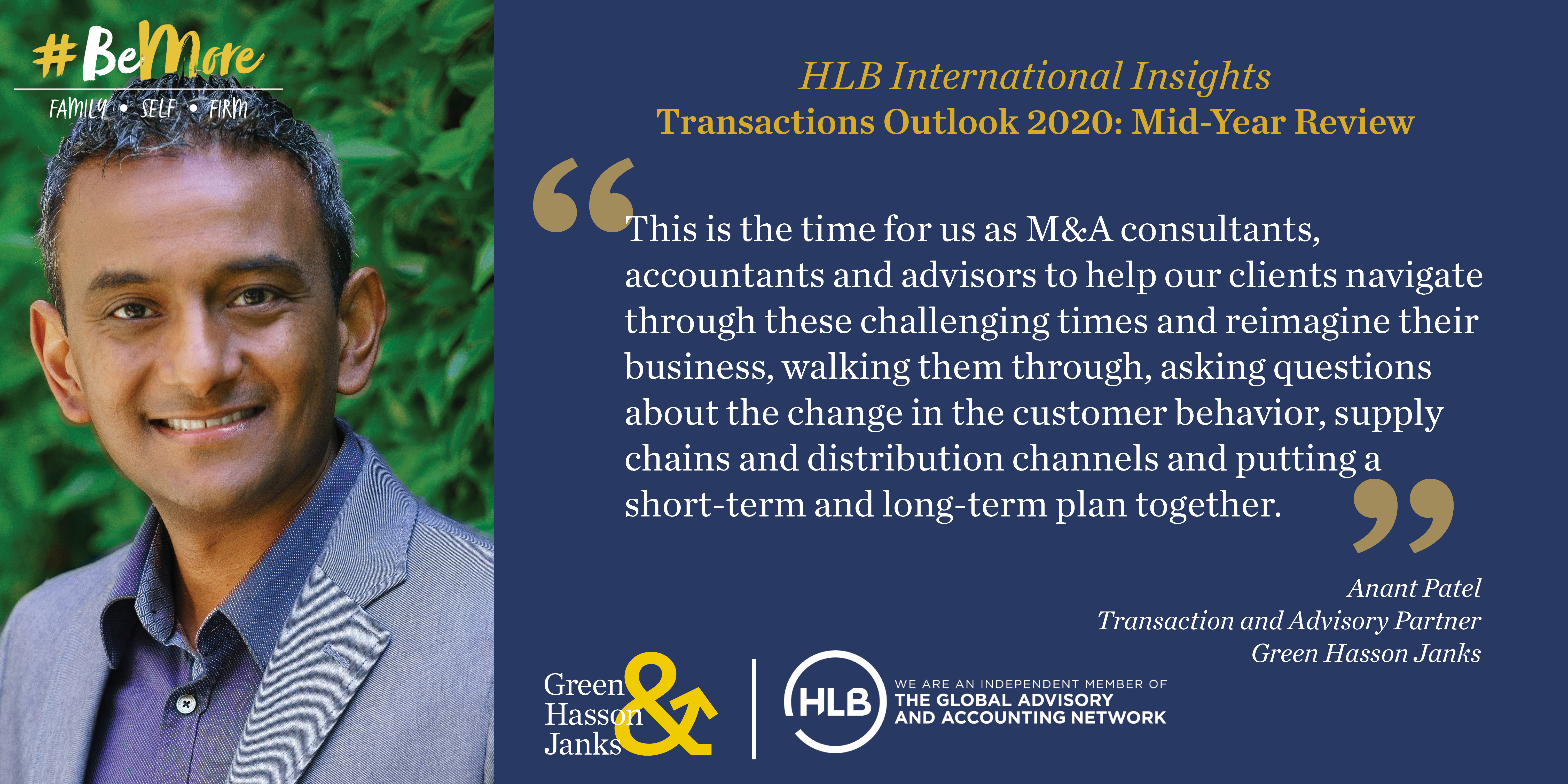Originally published in HLB Insights

The outbreak of COVID-19 has brought unprecedented challenges to the global economy, pausing much of the activity across the world. After a long spell of record-high M&A activity over the past decade, deal-making was brought to a screeching halt as the pandemic shock diffused throughout the world economy. What was once expected to be a mostly uneventful environment, soon transformed into an unprecedented disruption that exploded after a good start to the year.
As we weather this historic global health and economic crisis, it’s becoming evident that we are operating in a new – and to a large extent uncharted- M&A environment that continues to evolve. As dealmakers are trying to gain some clarity, the reality is that the economy will need to learn to operate under heightened uncertainty for a prolonged time. As the short and mid-term response continues to develop, and the economy is starting to accept that the resolve of the pandemic will take some time to emerge, the deal-making activity is showing signs of revival.
After the Transactions Outlook 2020: An Overview of M&A Trends across Regions published right at the onset of the COVID-19 outbreak in which we outlined our M&A market expectations for 2020, we are
revisiting the deal activity analysis to account for the unprecedented impact of the pandemic and help our clients reach a higher degree of clarity about what is expected in M&A space in the increasingly uncertain times ahead of us.
The Pandemic Impact
As 1H20 was nearing an end, the full impact of COVID-19 across the world economy started to emerge. The disruptive effect of the shock unparalleled both in terms of size and order was reflected in the M&A deal activity, particularly during the second quarter of 2020. According to the Global & Regional M&A Report 1H20 which was recently published by Mergermarket, deal volume fell by 32% from 1H20 to 1H19, (6,938 vs. 10,155 transactions), while deal values plummeted by staggering 52.7% (USD 901.6bn compared to USD 1.9tn) — an environment reminiscent of the aftermath of the financial crisis of 2008.
The difference when contrasting quarters is even starker – deal volume has fallen steeply from 4,308 deals in 1Q20 to 2,630 in 2Q20, with deal values dipping to USD 308.9bn from USD 592.6bn in the preceding quarter.
However, the impact of the virus outbreak propagated unevenly throughout the global economy and hence materialised differently across various regions of the world. Although the first affected by the virus, China experienced the least impact on its global buying activity with deal count declining by just 7% and deal values by 20.1% on a year-over-year basis, offering a glimpse of hope for other countries that the deal environment will head towards gradual recovery as the epidemiological situation improves – still reminding us that resurgences of COVID-19 will continue to constrain the upside. In contrast, the Americas, dominated by the US market, saw the most significant decline. Hindered not only by the pandemic but also political uncertainty stemming from the imminent presidential election and rising social unrest, US share of global M&A by value declined to 33.4% in 2020 compared to 52.8% in 2019, leading to an expansion of other regions, most notably Europe, (with a 32.3% market share) which slightly squeezed out Asia (27.7%) in achieving the largest market share gains. The European M&A activity declined by 30.6% – from USD 419.9bn in 1H19 to USD 291.5bn in 1H20, while the total value of US M&A activity declined to USD 274.5bn, which is the lowest half-year activity since 2003. ORBITT conducted a study covering the M&A market in Africa using data tracked on its platform to compare levels of deal activity between 2019 and 2020, documenting a 71% decrease in equity investors engaging in new investment leads (76 in H2 2019 vs. 47 in H1 2020).
Current Market Themes
Drawing a sharp demarcation line between the industries, the pandemic clearly set apart those that are struggling as highly impacted by the dramatic change in consumer behaviour and the consequences of global lockdown and those that are proving COVID-19 resistant. The former include healthcare, technology, essential retail and construction, while the latter cohort includes non-essential retail/consumer, manufacturing, restaurant/services and transportation.
Although the Global Financial Crisis remains the closest historical reference, the pandemic has generated its own unique challenges and opportunities. Unlike the financial crisis, which resulted in the collapse of the debt market, the debt market and the availability of capital today are robust. There had been more tightening, particularly on the senior debt market in terms of leverage and pricing risk, but also an expectation that M&A transactions will pick up in 2021, with a possible exception of private equity activity which may see a bit slower recovery.
We are already observing that the terms of deals are changing, with a more noticeable presence of earnouts. Valuations are starting to incorporate the effects of the pandemic, with new metrics such as EBITDA_C reflecting the COVID-19 impact as buyers are beginning to price this risk factor to ensure that they have a full understanding of the target’s operations.
On a positive factors side, customer confidence remains positive in the wake of opening up of the economy. As strategic acquisitions are still active, today’s environment represents a ripe market for strategic acquisitions, while corporate divestitures have seen the rise. Further, tech and tech-enabled businesses are performing relatively well and the low-interest-rate environment allows favourable terms of debt financing while the corporate sector and private equity investors maintain healthy volumes of cash and investable capital.
On a negative side, the world economy is confronted with a risk of multiple waves of the outbreaks becoming a reality before a vaccine becomes available, potentially resulting in borrowing requirements tightening due to heightened uncertainty. Finally, pre-COVID-19 geopolitical and trade tensions that continue to remain unresolved further exacerbate economic uncertainties.
As a result of the current environment, traditional private equity leveraged buyouts are side-lined due to pricing risk and ability to raise senior debt, while investors are seeking value acquisitions structured often as 100% equity deals. Strategic acquisitions are aimed at enhancing competitive advantage.
Long-Term Market Themes
Although the world is currently immersed in dealing with the imminent challenges brought on by the COVID-19 outbreak, there are long term market themes — both opportunities and challenges — that will stay relevant beyond the pandemic.
On the positive side, we are witnessing an ongoing demographic change leading to the intra-generational wealth shift between the so-called baby boomers and X generation and Millennials who exhibit a lack of the “next-generation mentality“. This will result in an increasing number of family-owned businesses and privately held companies coming to the market, opening up compelling opportunities to capitalise on this emerging long-term trend. Acquisitions will continue to be a key driver, while the professionalization of the Lower Middle Market that has been happening over the past decade will continue. The expectation is that capital will continue to be increasingly available, including debt at low interest rates.
On the negative side of the equation, the uncertainty as to what shape the economic recovery will take still remains, while the question of whether the lack of quality companies for sale will lead to stronger valuations for those that are still available. Finally, as the world is starting to emerge from the immediate pandemic shock, we are witnessing an increasing push for economic sovereignty, which may leave the de-globalized world economy in the post-pandemic world turning M&A markets more domestic-focused.
The Role of Advisors
As the world settles into the new normal where heightened uncertainty is the norm rather than an anomaly, companies and investors alike will start shifting their focus from dealing with short term pandemic shock to managing elements of mid and long term environments that will bring its own set of opportunities and headwinds. In a sort poll survey among our own advisors about the potential timeline of M&A recovery, the majority of respondents expect M&A activity to pick up in Q2 2021 (45.45%), while almost a third (31.82) expect the recovery to materialise in Q4 2021. In contrast, the most optimistic cohort that counts 13.64% of respondents holds that Q4 2020 will bring the expected pick up, while those on the most pessimistic end of the spectrum (9.09%) anticipate that we will have to wait beyond 2021 to see pick up in this space.
As the companies and investors are seeking to gain clarity in these unprecedented times, the role of strategic advisors is evolving to assist the clients in reimagining and remodelling their businesses, enabling them to navigate through these volatile times.
As highlighted by Anant Patel, HLB’s Global Transaction Advisory Services Leader, “This is the time for us as M&A consultants, accountants and advisors to help our clients navigate through these challenging times and reimagine their business, walking them through, asking questions about the change in the customer behaviour, supply chains and distribution channels and putting a short term and long term plan together.”


